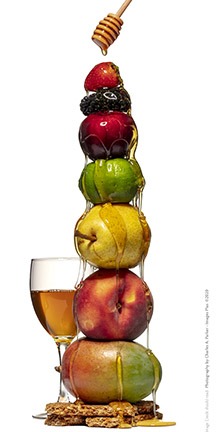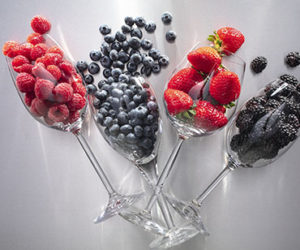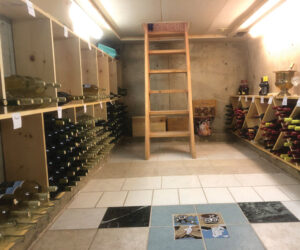
Most all of the honey-based wines fall into the larger category of meads. Given the history and ubiquity of honey-based wines throughout the world, it’s not surprising they are an amazingly diverse class of wines. Different regions around the world have different specialties and different names for the various meads and honey wines, making for a fairly complex and often misunderstood beverage. Love them or not, it’s an interesting study of both history and experimentation possibilities with a dizzying array of combinations and variations. Let’s start off with the intricacies of honey before jumping into a few of the more popular variants.
Most folks know that the qualities of honey produced from bees is dependent upon the source flowers. Honey derived from orange blossoms when compared to honey from buckwheat is going to taste wildly different. And just as with grape varietals, these different honey types will also produce different tasting meads. Meadmakers may want to blend different honey types to produce a more complex flavor profile or keep the honey as a single varietal to highlight the qualities of a certain flower type or source region. For a first-time meadmaker blending honey types may be a safe way to go or opting for a more neutral-tasting honey like clover is a good starting point.
The World Of Meads
A honey-based wine can be sweet, semi-sweet, or dry depending on the goal of the meadmaker (or the conditions provided to the yeast). Carbonation is also an option for meadmakers that may like to add some spritz to their mead. Carbonation can range from seemingly almost still to Champagne-level of bubbles.
Standard Mead: What most folks refer to as traditional mead, it’s typically fermented from either a single honey type or a blend of two or more honey types. They will typically clock in between 7-14% ABV.
Hydromel (Session) Mead: At its core, this is a more watered-down version of standard mead, clocking in between 3.5-7% ABV. This requires skill from the meadmaker in order to make the mead taste full-bodied and these will often be carbonated for added mouthfeel.
Sack Mead: On the other end of the spectrum, sack mead is a potent concoction in the 14%+ ABV realm. A clean fermentation where the yeast can properly finish while keeping the alcohols hidden is a challenge.
Melomel: To keep things simple, we can say melomel is a honey-based wine that has some sort of fruit added. There are an abundant number of sub-categories of melomels based on what fruit is added, most notably cyser (apple mead) and pyment (grape mead). The sky is the limit as to what combination of fruits (dried or fresh) a meadmaker can mix in with the various honey varieties to create their melomel beverage.
Metheglin: Also a very broad category, but generally this refers to honey wines that have been spiced. A meadmaker can use herbs, vegetables, or other spices to create their metheglin. Technically fruit can also be added to a spiced mead and the resulting beverage will still be called a metheglin. Spices like vanilla, ginger, chamomile, and lavender are just a few that are popular among meadmakers.
Braggot: Just as pyment is a cross of wine and mead, braggot is a cross of beer and mead. Where a honey beer ends and braggot begins is a little blurry, but generally a braggot should have honey/mead notes come through in either the nose and/or flavor. But there is no definitive line in the sand separating the two classifications.
There is also a whole world to explore of different honey-based wines from around the globe. Ethiopian t’ej, Polish czworniak, Mexican acan, Nepalese dandaghare, and Finnish sima are just a few examples of some of the different honey-based wines to research.
Feeding The Yeast
One of the biggest challenges for meadmakers is the balance of yeast nutrients. Honey doesn’t afford meadmakers the nutrients, most notably nitrogen, that yeast require for a proper and clean fermentation. This is why historically meadmakers needed to add things like grape juice or unfermented beer to the honey in order to provide some nutrients for yeast. But even with those additions, meadmakers are encouraged to add more nutrients. Too much though and the mead can be detrimentally affected. This is the fine line meadmakers need to walk. How much nutrients to add is highly dependent upon your starting material, but generally meadmakers will slowly “feed” the yeast over several weeks of fermentation.
Other Possible Additions
Think about what other additions grape winemakers may add and most all of them are possibly used in honey-based wines as well. Tannins, acids, oak, fortifying liquors, etc. are just a few examples of additions you’ll find in honey-based wines. The selection of yeast can also greatly affect the final product. Some meadmakers may purposefully add non-Saccharomyces strains like Brettanomyces or bacterial strains to get a different profile.
If you would like to try your hand at honey wine and would like to learn more, I recommend either The Compleat Meadmaker by Ken Schramm or The Complete Guide to Making Mead by Steve Piatz. Or you can find several great articles at winemakermag.com found under “Meadmaking.”






